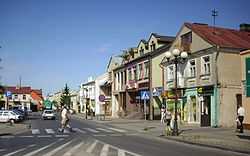Łosice
| Łosice | ||
|---|---|---|
 | ||
| ||
 Łosice | ||
| Coordinates: 52°13′N 22°43′E / 52.217°N 22.717°E | ||
| Country |
| |
| Voivodeship | Masovian | |
| County | Łosice County | |
| Gmina | Gmina Łosice | |
| Established | 13th century | |
| Town rights | before 1505 | |
| Government | ||
| • Mayor | Janusz Stanisław Kobyliński | |
| Area | ||
| • Total | 23.75 km2 (9.17 sq mi) | |
| Population (2006) | ||
| • Total | 7,252 | |
| • Density | 310/km2 (790/sq mi) | |
| Time zone | CET (UTC+1) | |
| • Summer (DST) | CEST (UTC+2) | |
| Postal code | 08-200 | |
| Area code(s) | +48 83 | |
| Car plates | WLS | |
| Website | http://www.losice.pl/ | |
Łosice [wɔˈɕit͡sɛ] (![]() ) is a town in eastern Poland. It is situated in Masovian Voivodeship (since 1999); previously it was in Biała Podlaska Voivodeship (1975-1998). It is currently the seat of Łosice County.
) is a town in eastern Poland. It is situated in Masovian Voivodeship (since 1999); previously it was in Biała Podlaska Voivodeship (1975-1998). It is currently the seat of Łosice County.
Historical Overview
Łosice was first mentioned in 1264 as a medieval settlement from around 11th – 13th centuries; situated near the village of Dzięcioły. However, the location prevented the town's further development and in late 15th and 16th century, the community was moved to Łosice's present location.[1] The first documented history of the town is preserved in the Privileges issued by King Aleksander Jagiellończyk in Radom on May 10, 1505; thus releasing Łosice from under the Ruthenian and Lithuanian city laws, and giving it more progressive Magdeburg rights. Private judiciary was revoked enabling the inhabitants to form a municipal government with mayor and city council. The Privileges allowed also for weekly markets and four fairs a year at a more convenient location; and, proposed the establishment of a town hall.[1]
By 1551, there were two Orthodox churches, and two Roman Catholic churches in Łosice founded and endowed by King Sigismund I. Throughout the 16th century the town enjoyed a period of economic development, with most inhabitants living of trade in leather, furs, and salt; as well as crafts, and a variety of services. According to 1580 registry, there were 47 carpenters, 32 tailors, 20 bakers, 10 butchers, 7 stove fitters, and 4 blacksmiths in the town, not to mention millers, a locksmith, a goldsmith and a weaver. Nearly a complete destruction of Łosice came during the Swedish Deluge in 1655-1660. Only in the second half of the 18th century, the town began to gradually recover.[1]
After the Third partition of Poland Łosice fell under the Austrian rule. Later, as a result of the Treaty of Vienna in 1815, it came under the rule of the Tsar of Russia. During the November Uprising a Polish battalion of Colonel Raczyński formed in the town with many local residents. Before and during the January Uprising against the Russian rulership, local doctor Władysław Czarkowski led the unit of several hundred conspirators on attack against the garrisons. After the Uprising's defeat, the invader brought reprisals against the Polish population. Łosice had been deprived of the Roman Catholic parish, and in 1867 lost its civic rights. The process of Russification intensified right until the liberation of Poland.[1]
Points of interest
- Neo-Gothic parish church of St. Zygmunt, built between 1906-1909
- Former convent of Communion priests, rebuilt as hospital
- Neo-Gothic cemetery chapel of St. Stanisław from 1845
- Baroque roadside statue erected in 1775
- Monument to Children of Zamojszczyzna who died in Łosice during the Nazi German kidnaping raid of 1943, located at the local cemetery
- Parish church in Niemojki of 1783
The biggest attraction in Łosice is a recreational reservoir, situated near the city center and the train station. In summer, there is a concession there as well as, kayak-and-water-bike rentals. The complex is located near the city park, built at the site of the former Jewish cemetery which was destroyed by the Nazis during World War II. The cemetery was established in 1690 under the privilege granted by King Jan III Sobieski. The collection of tombstones put on display, is the largest collection of Jewish sacral art in southern Podlasie region. The oldest stonework dates back to the first half of the 19th century.[1]
Notes and references
- Jewish Community in Łosice on Virtual Shtetl
Coordinates: 52°13′N 22°43′E / 52.217°N 22.717°E
| |||||||||||||
| ||||||||||

